The Unconventional Peridotite-Related Mg-Fe-B Skarn of the El Robledal, SE Spain
Abstract
1. Introduction
2. Geological Setting
3. Materials and Methods
4. Results
4.1. The El Robledal Deposit
4.2. Mineralogy of the Skarn Zones
4.2.1. Ludwigite–Magnetite Zone
4.2.2. Magnetite-Szaibelyite Zone
4.3. Mineralogy of the Reaction Zone and Migmatites
4.4. Mineral Chemistry
4.5. Solid Mineral Inclusions in Oxides
4.6. Microstructure of the Ores
5. Discussion
5.1. Skarn Topology
5.2. Mineral Paragenesis and Skarn Evolution
5.2.1. Metamorphic Stage
5.2.2. Prograde Stage
5.2.3. Retrograde Stage
5.3. Effects of Deformation
5.4. Source of Boron
5.5. Genetic Model
6. Conclusions
Supplementary Materials
Author Contributions
Funding
Institutional Review Board Statement
Informed Consent Statement
Data Availability Statement
Acknowledgments
Conflicts of Interest
References
- Helvacı, C. Borate deposits: An overview and future forecast with regard to mineral deposits. J. Boron 2017, 2, 59–70. [Google Scholar]
- Pertsev, N.N. Magnesian skarns. In Skarns. Their Genesis and Metallogeny; Aksyuk, A.M., Ed.; Theophrastus Publications: Athens, Greece, 1991; pp. 299–324. [Google Scholar]
- Aleksandrov, S.M. The Geochemistry of Skarn and Ore Formation in Dolomites; CRC Press: Boca Raton, FL, USA, 1998; pp. 1–301. [Google Scholar]
- Meinert, L.D.; Dipple, G.M.; Nicolescu, Ş. World skarn deposits. In Economic Geology 100th Anniversary; Hedenquist, J.W., Thompson, J.F.H., Goldfarb, R.J., Richards, J.P., Eds.; Elsevier Science B.V.: Amsterdam, The Netherlands, 2005; Volume 1905–2005, pp. 299–336. [Google Scholar]
- Korzhinskii, D.S. The theory of metasomatic zoning. Miner. Depos. 1968, 3, 222–231. [Google Scholar] [CrossRef]
- Aleksandrov, S.M. Skarn-greisen deposits of the lost river and mount ear ore field, Seward Peninsula, Alaska, United States. Geochem. Int. 2010, 48, 1220–1236. [Google Scholar] [CrossRef]
- Marincea, S. Magnesian borates and associated minerals in the Cacova Ierii skarn deposit (Apuseni Mountains Romania). Geonomos 2001, 8, 1–7. [Google Scholar] [CrossRef]
- Woodford, D.T.; Sisson, V.B.; Leeman, W.P. Boron metasomatism of the Alta stock contact aureole, Utah: Evidence from borates, mineral chemistry, and geochemistry. Am. Mineral. 2001, 86, 513–533. [Google Scholar] [CrossRef]
- Aleksandrov, S.M. Endogenous transformations of kotoite in calciphyres at magnesian-skarn deposits of boron. Geochem. Int. 2007, 45, 666–684. [Google Scholar] [CrossRef]
- Aleksandrov, S.M. Metasomatic transformations of carbonate rocks observable in quarries of Riverside, California, United States. Geochem. Int. 2011, 49, 711–725. [Google Scholar] [CrossRef]
- Aleksandrov, S.M.; Troneva, M.A. Genesis and composition of endogenous borates in the skarns of the Eastern and Central Pyrenees. Geochem. Int. 2011, 49, 802–814. [Google Scholar] [CrossRef]
- Tančić, P.; Dimitrijević, R.; Poznanović, M.; Pačevski, A.; Sudar, S. Crystal Structure and Chemical Composition of Ludwigite from Vranovac Ore Deposit (Boranja Mountain, Serbia). Acta Geol. Sin. 2012, 86, 1524–1538. [Google Scholar] [CrossRef]
- Bilohuščin, V.; Uher, P.; Koděra, P.; Milovská, S.; Mikuš, T.; Bačík, P. Evolution of borate minerals from contact metamorphic to hydrothermal stages: Ludwigite-group minerals and szaibélyite from the Vysoká–Zlatno skarn, Slovakia. Mineral. Petrol. 2017, 111, 643–658. [Google Scholar] [CrossRef]
- Marincea, S.; Dumitraş, D.-G. Contrasting types of boron-bearing deposits in magnesian skarns from Romania. Ore Geol. Rev. 2019, 112, 102952. [Google Scholar] [CrossRef]
- Gervilla, F.; González-Jiménez, J.M.; Hidas, K.; Marchesi, C.; Piña, R. Geology and Metallogeny of the Upper Mantle Rocks from the Serranía de Ronda; Mineralogical Spanish Society: Ronda, Spain, 2019; p. 122. [Google Scholar]
- Andrieux, J.; Fontbote, J.-M.; Mattauer, M. Sur un modele explicatif de l’arc de Gibraltar. Earth Planet. Sci. Lett. 1971, 12, 191–198. [Google Scholar] [CrossRef]
- Dewey, J.F.; Helmann, M.L.; Turco, E.; Hutton, D.H.W.; Knott, S.D. Kinematics of the western Mediterranean. In Alpine Tectonics; Coward, M.P., Dietrich, D., Park, R.G., Eds.; Geological Society Special Publication; Geological Society of London: London, UK, 1989; Volume 45, pp. 265–283. [Google Scholar] [CrossRef]
- Balanyá, J.C.; García-Dueñas, V. Les directions structurales dans le Domaine d’Alborán de part et d’autre du Détroit de Gibraltar. Comptes rendus de l’Académie des sciences. Série 2, Mécanique, Physique, Chimie. Sci. L’univers Sci. Terre 1987, 304, 929–932. [Google Scholar]
- Platt, J.P.; Behr, W.M.; Johanesen, K.; Williams, J.R. The Betic-Rif arc and its orogenic hinterland: A review. Annu. Rev. Earth Planet. Sci. 2013, 41, 313–357. [Google Scholar] [CrossRef]
- Azdimousa, A.; Jabaloy-Sánchez, A.; Talavera, C.; Asebriy, L.; González-Lodeiro, F.; Evans, N.J. Detrital zircon U-Pb ages in the Rif Belt (northern Morocco): Paleogeographic implications. Gondwana Res. 2019, 70, 133–150. [Google Scholar] [CrossRef]
- Balanyá, J.C.; Garcia-Duenas, V.; Azañón, J.M.; Sánchez-Gómez, M. Alternating contractional and extensional events in the Alpujarride Nappes of the Alboran domain (Betics, Gibraltar arc). Tectonics 1997, 16, 226–238. [Google Scholar] [CrossRef]
- Massaki, O. The Ronda peridotite: Garnet-, spinel-, and plagioclase-lherzolite facies and the P-T trajectories of a high-temperature mantle intrusion. J. Petrol. 1980, 21, 533–572. [Google Scholar] [CrossRef]
- Reisberg, L.; Lorand, J.-P. Longevity of sub-continental mantle lithosphere from osmium isotope systematics in orogenic peridotite massifs. Nature 1995, 376, 159–162. [Google Scholar] [CrossRef]
- Marchesi, C.; Griffin, W.L.; Garrido, C.J.; Bodinier, J.-L.; O’Reilly, S.Y.; Pearson, N.J. Persistence of mantle lithospheric Re–Os signature during asthenospherization of the subcontinental lithospheric mantle: Insights from in situ isotopic analysis of sulfides from the Ronda peridotite (Southern Spain). Contrib. Mineral. Petrol. 2010, 159, 315–330. [Google Scholar] [CrossRef]
- González-Jiménez, J.M.; Villaseca, C.; Griffin, W.L.; Belousova, E.A.; Konc, Z.; Ancochea, E.; O’Reilly, S.Y.; Pearson, N.J.; Garrido, C.J.; Gervilla, F. The architecture of the European-Mediterranean lithosphere: A synthesis of the Re-Os evidence. Geology 2013, 41, 547–550. [Google Scholar] [CrossRef]
- González-Jiménez, J.M.; Marchesi, C.; Griffin, W.L.; Gutiérrez-Narbona, R.; Lorand, J.-P.; O’Reilly, S.Y.; Garrido, C.J.; Gervilla, F.; Pearson, N.J.; Hidas, K. Transfer of Os isotopic signatures from peridotite to chromitite in the subcontinental mantle: Insights from in situ analysis of platinum-group and base-metal minerals (Ojén peridotite massif, southern Spain). Lithos 2013, 164–167, 74–85. [Google Scholar] [CrossRef]
- Tubía, J.M.; Cuevas, J.; Esteban, J.J. Localization of deformation and kinematic shift during the hot emplacement of the Ronda peridotites (Betic Cordilleras, southern Spain). J. Struct. Geol. 2013, 50, 148–160. [Google Scholar] [CrossRef]
- Esteban, J.J.; Cuevas, J.; Vegas, N.; Tubía, J.M. Deformation and kinematics in a melt-bearing shear zone from the Western Betic Cordilleras (Southern Spain). J. Struct. Geol. 2008, 30, 380–393. [Google Scholar] [CrossRef]
- Westerhof, A.B. Genesis of magnetite ore near Marbella, Southern Spain: Formation by oxidation of silicates in polymetamorphic gedrite-bearing and other rocks. In GUA Papers of Geology; Stichtung GUA: Amsterdam, The Netherlands, 1975; p. 216. [Google Scholar]
- González-Pérez, I.; González-Jiménez, J.M.; Gervilla, F.; Fanlo, I.; Tornos, F.; Colás, V.; Arranz, E.; Hanchar, J.; Abad-Ortega, M.D.M.; Moreno-Abril, A.J.; et al. Genesis and evolution of the San Manuel iron skarn deposit (Betic Cordillera, SW Spain). Ore Geol. Rev. 2022, 141, 104657. [Google Scholar] [CrossRef]
- Torres-Roldán, R.L. Aplicación de los geotermómetros y geobarómetros de cordierita-granate y cordierita-biotita al discernimiento de la evolución del proceso anatéctico en el complejo migmatítico de la unidad de (tipo) Blanca. Boletín Soc. Española Mineral. 1981, 2, 99–118. [Google Scholar]
- Barich, A.; Acosta-Vigil, A.; Garrido, C.J.; Cesare, B.; Tajčmanová, L.; Bartoli, O. Microstructures and petrology of melt inclusions in the anatectic sequence of Jubrique (Betic Cordillera, S Spain): Implications for crustal anatexis. Lithos 2014, 206–207, 303–320. [Google Scholar] [CrossRef]
- Acosta-Vigil, A.; Rubatto, D.; Bartoli, O.; Cesare, B.; Meli, S.; Pedrera, A.; Azor, A.; Tajčmanová, L. Age of anatexis in the crustal footwall of the Ronda peridotites, S Spain. Lithos 2014, 210–211, 147–167. [Google Scholar] [CrossRef]
- Sanz de Galdeano, C.; Ruiz Cruz, M.D. Late Palaeozoic to Triassic formations unconformably deposited over the Ronda peridotites (Betic Cordilleras): Evidence for their Variscan time of crustal emplacement. Estud. Geológicos 2016, 72, e043. [Google Scholar] [CrossRef]
- Sánchez-Navas, A.; García-Casco, A.; Mazzoli, S.; Martín-Algarra, A. Polymetamorphism in the Alpujarride Complex, Betic Cordillera, South Spain. J. Geol. 2017, 125, 637–657. [Google Scholar] [CrossRef]
- Barich, A. Unravelling the Anatectic History of the Lower Continental Crust through the Petrology of Melt Inclusions and Lu-Hf Garnet Geochronology: A Case Study from the Western Alpujárrides (Betic Cordillera, S. Spain). Ph.D. Thesis, University of Granada, Granada, Spain, 2016. [Google Scholar]
- Tubía, J.; Cuevas, J.; Ibarguchi, J. Sequential development of the metamorphic aureole beneath the Ronda peridotites and its bearing on the tectonic evolution of the Betic Cordillera. Tectonophysics 1997, 279, 227–252. [Google Scholar] [CrossRef]
- Sánchez-Rodríguez, L.; Gebauer, D. Mesozoic formation of pyroxenites and gabbros in the Ronda area (southern Spain), followed by Early Miocene subduction metamorphism and emplacement into the middle crust: U-Pb sensitive high-resolution ion microprobe dating of zircon. Tectonophysics 2000, 316, 19–44. [Google Scholar] [CrossRef]
- Loomis, T.P. Contact metamorphism of the pelitic rocks by the Ronda ultramafic intrusion, southern Spain. Geol. Soc. Am. Bull. 1972, 83, 2249–2474. [Google Scholar] [CrossRef]
- Torres-Roldán, R.L. The tectonic subdivision of the Betic Zone (Betic Cordilleras, Southern Spain); Its significance and one possible geotectonic scenario for the westernmost Alpine belt. Am. J. Sci. 1979, 279, 19–51. [Google Scholar] [CrossRef]
- Torres-Roldán, R.L. Fractionated melting of metapelite and further crystal-melt equilibria—The example of the Blanca Unit migmatite complex, north of Estepona (southern Spain). Tectonophysics 1983, 96, 95–123. [Google Scholar] [CrossRef]
- Tubía, J.M.; Cuevas, J. High-temperature emplacement of the Los Reales peridotite nappe (Betic Cordillera, Spain). J. Struct. Geol. 1986, 473, 473–482. [Google Scholar] [CrossRef]
- Vigil, A.A. Estudio de los Fenómenos de Fusión Cortical y Generación de Granitoides Asociados a las Peridotitas de Ronda. Ph.D. Thesis, University of Granada, Granada, Spain, 1998; p. 305. [Google Scholar]
- Pedrera, A.; Galindo-Zaldívar, J.; Acosta-Vigil, A.; Azor, A.; González-Menéndez, L.; Rodríguez-Fernández, L.R.; Ruiz-Constán, A. Serpentinization-driven extension in the Ronda mantle slab (Betic Cordillera, S. Spain). Gondwana Res. 2016, 37, 207–215. [Google Scholar] [CrossRef]
- Cuevas, J.; Esteban, J.J.; Tubía, J.M. Tectonic implications of the granite dyke swarm in the Ronda peridotites (Betic Cordilleras, Southern Spain). J. Geol. Soc. 2006, 163, 631–640. [Google Scholar] [CrossRef]
- Mazzoli, S.; Martín-Algarra, A.; Reddy, S.M.; Sánchez-Vizcaíno, V.L.; Fedele, L.; Noviello, A. The evolution of the footwall to the Ronda subcontinental mantle peridotites: Insights from the Nieves Unit (western Betic Cordillera). J. Geol. Soc. 2013, 170, 385–402. [Google Scholar] [CrossRef]
- Priem, H.N.A.; Boelrijk, N.A.I.M.; Hebeda, E.H.; Oen, I.S.; Verdurmen, E.A.T.; Verschure, R.H. Isotopic dating of the emplacement of the ultramafic masses in the Serranía de Ronda, Southern Spain. Contrib. Mineral. Petrol. 1979, 70, 103–109. [Google Scholar] [CrossRef]
- Rossetti, F.; Theye, T.; Lucci, F.; Bouybaouene, M.L.; Dini, A.; Gerdes, A.; Phillips, D.; Cozzupoli, D. Timing and modes of granite magmatism in the core of the Alboran Domain, Rif chain, northern Morocco: Implications for the Alpine evolution of the western Mediterranean. Tectonics 2010, 29, TC2017. [Google Scholar] [CrossRef]
- Esteban, J.J.; Cuevas, J.; Tubía, J.M.; Sergeev, S.; Larionov, A. A revised Aquitanian age for the emplacement of the Ronda peridotites (Betic Cordilleras, southern Spain). Geol. Mag. 2011, 148, 183–187. [Google Scholar] [CrossRef]
- González-Jiménez, J.M.; Marchesi, C.; Griffin, W.L.; Gervilla, F.; Belousova, E.A.; Garrido, C.J.; Romero, R.; Talavera, C.; Leisen, M.; O’Reilly, S.Y.; et al. Zircon recycling and crystallization during formation of chromite- and Ni-arsenide ores in the subcontinental lithospheric mantle (Serranía de Ronda, Spain). Ore Geol. Rev. 2017, 90, 193–209. [Google Scholar] [CrossRef]
- Mazzoli, S.; Algarra, A.M. Deformation partitioning during transpressional emplacement of a ‘mantle extrusion wedge’: The Ronda peridotites, western Betic Cordillera, Spain. J. Geol. Soc. 2011, 168, 373–382. [Google Scholar] [CrossRef]
- Bonazzi, P.; Menchetti, S. Contribution to the crystal chemistry of the minerals of the ludwigite-vonsenite series. Neues Jahrb. Für Mineral. Mon. 1989, 2, 69–83. [Google Scholar]
- Takéuchi, Y.; Kogure, T. The structure type of ludwigite. Z. Für Krist. 1992, 200, 161–167. [Google Scholar] [CrossRef]
- Marincea, S. The influence of Al on the physical and crystallographic properties of ludwigite in three Romanian occurrences. Eur. J. Mineral. 2000, 12, 809–823. [Google Scholar] [CrossRef]
- Bloise, A.; Barrese, E.; Apollaro, C.; Miriello, D. Synthesis of ludwigite along the Mg2FeBO5 Mg2AlBO5 join. Neues Jahrb. Für Mineral. Abh. 2010, 187, 217–223. [Google Scholar] [CrossRef]
- Marincea, S. Ludwigite from the type locality, Ocna de Fier, Romania: New data and review. Can. Mineral. 1999, 37, 1343–1362. [Google Scholar]
- Aleksandrov, S.M.; Troneva, M.A. Composition and genesis of endogenous borates from the Pitkáranta ore field, Karelia. Geochem. Int. 2009, 47, 914. [Google Scholar] [CrossRef]
- Aleksandrov, S.M. Geochemical features of the endogenous hydration of magnesium borates. Geochem. Int. 2008, 46, 578–594. [Google Scholar] [CrossRef]
- Plechov, P.Y.; Shcherbakov, V.D.; Nekrylov, N.A. Extremely magnesian olivine in igneous rocks. Russ. Geol. Geophys. 2018, 59, 1702–1717. [Google Scholar] [CrossRef]
- Hazen, R.M. Effects of temperature and pressure on the cell dimension and X-ray temperature factors of periclase. Am. Mineral. 1976, 61, 266–271. [Google Scholar]
- Falini, G.; Foresti, E.; Gazzano, M.; Gualtieri, A.F.; Leoni, M.; Lesci, I.G.; Roveri, N. Tubular-shaped stoichiometric chrysotile nanocrystals. Chem. Eur. J. 2004, 10, 3043–3049. [Google Scholar] [CrossRef] [PubMed]
- Graf, D.L. Crystallographic tables for the rhombohedral carbonates. Am. Mineral. 1961, 46, 1283–1316. [Google Scholar]
- Curras, J.; Torres-Ruiz, J. El Skarn magnésico de magnetita-ludwigita del Cañuelo (Cordilleras Béticas Occidentales). Bol. Soc. Esp. Min. 1992, 15, 319–322. [Google Scholar]
- Graf, D.L.; Goldsmith, J.R. Dolomite–Magnesian Calcite Relations at Elevated Temperatures and CO2 Pressures. Geochim. Cosmochim. Acta 1955, 7, 109–128. [Google Scholar] [CrossRef]
- Ferry, J.M.; Rumble, D., III. Formation and destruction of periclase by fluid flow in two contact aureoles. Contrib. Mineral. Petrol. 1997, 128, 313–334. [Google Scholar] [CrossRef]
- Simandl, G.J.; Paradis, S.; Irvine, M. Brucite–Industrial Mineral with a Future. Geosci. Can. 2007, 34, 49–80. [Google Scholar]
- Rice, J.M. Contact metamorphism of impure dolomitic limestone in the Boulder Aureole, Montana. Contrib. Mineral. Petrol. 1977, 59, 237–259. [Google Scholar] [CrossRef]
- Holland, T.J.B.; Powell, R. An internally consistent thermodynamic data set for phases of petrological interest. J. Metamorph. Geol. 1998, 16, 309–343. [Google Scholar] [CrossRef]
- Pascal, M.-L.; Fonteilles, M.; Boudouma, O.; Principe, C. Qandilite from Vesuvius skarn ejecta: Conditions of formation and miscibility gap in the ternary spinel-qandilite-magnesioferrite. Can. Mineral. 2011, 49, 459–485. [Google Scholar] [CrossRef]
- Hu, H.; Li, J.-W.; Lentz, D.; Ren, Z.; Zhao, X.-F.; Deng, X.-D.; Hall, D. Dissolution–reprecipitation process of magnetite from the Chengchao iron deposit: Insights into ore genesis and implication for in-situ chemical analysis of magnetite. Ore Geol. Rev. 2014, 57, 393–405. [Google Scholar] [CrossRef]
- Pavlov, A.L. Effect of partial pressure of oxygen and temperature on formation of ferrites of magnesium and iron in paragenesis with hematites. Int. Geol. Rev. 1967, 9, 1576–1582. [Google Scholar] [CrossRef]
- Watanabe, T. On kotoite and suanite. In Geology and Mineral Resources of the Far East; University of Tokyo Press: Tokyo, Japan, 1967; Volume 1, pp. 236–267. [Google Scholar]
- Barsukov, V.L.; Deryugina, N.N. An experimental investigation of the conditions of formation of kotoite-asharite ores. Geokhimiya 1960, 1, 66–71. [Google Scholar]
- Barsukov, V.L.; Egorov, A.P. Some geochemical characteristics of conditions of formation of hypogene borate deposits. Geokhimiya 1957, 8, 790–801. [Google Scholar]
- Grigorev, A.P.; Nekrasov, I. Hydrothermal synthesis of minerals of ludwigite-vonsenite series. Dokl. Akad. Nauk. SSSR 1963, 151, 671. [Google Scholar]
- Kravchuk, T.A.; Nekrasov, I.Y.; Grigoriev, A.P. Conditions of formation for the minerals in the ludwigite-vonsenite series according to experimental data. Zap Vses Min. Obs. 1966, 95, 272–286. (In Russian) [Google Scholar]
- Bloise, A.; Barrese, E. Synthesis of isomorphic vonsenite-ludwigite series. Neues Jahrb. Für Mineral. Abh. 2009, 186, 345–350. [Google Scholar] [CrossRef]
- Barsukov, V.L.; Kuril’chikova, G.E. On the Formation Conditions of Endogenous Ascharite. Geokhimiya 1957, 4, 312–319. [Google Scholar]
- Pertsev, N.N. Metamorphism and High-Temperature Metasomatism of Carbonates; Nauka Publishing: Moscow, Russia, 1977; pp. 1–256. (In Russian) [Google Scholar]
- Peng, Q.-M.; Palmer, M.R. The paleoproterozoic Mg and Mg-Fe borate deposits of Liaoning and Jilin provinces, Northeast China. Econ. Geol. 2002, 97, 93–108. [Google Scholar] [CrossRef]
- Pertsev, N.N. Boron Mineral Assemblages in Magnesian Skarns; Nauka Publishing: Moscow, Russia, 1971. (In Russian) [Google Scholar]
- Aleksandrov, S.M. Geochemistry of Boron and Tin in Magnesian Skarn Deposits; Nauka Publishing: Moscow, Russia, 1982; p. 272. (In Russian) [Google Scholar]
- Nefedov, E.I. Berborite, a new mineral. In Doklady Akademii Nauk SSSR Earth Science Sections; American Geological Institute: Washington, DC, USA, 1967; Volume 174, pp. 114–117. [Google Scholar]
- Nefedov, E.I.; Griffin, W.L.; Kristiansen, R. Minerals of the schoenfliesite-wickmanite series from Pitkaranta, Karelia, USSR. Can. Mineral. 1977, 15, 437–445. [Google Scholar]
- Marincea, S. Cristallochimie et Propriétés Physiques des Borates Magnésiens des Skarns de la Province Banatitique de Roumanie. Ph.D. Thesis, Instituto Politécnico Nacional de Grenoble, Grenoble, France, 1998. [Google Scholar]
- Rosière, C.A.; Siemes, H.; Quade, H.; Brokmeier, H.-G.; Jansen, E.M. Microstructures, textures and deformation mechanisms in hematite. J. Struct. Geol. 2001, 23, 1429–1440. [Google Scholar] [CrossRef]
- Ghosh, B.; Konar, R. Textural developments in chromite deforming under eclogite-facies conditions from the Neoarchaean Sittampundi anorthosite complex, southern India. Geol. J. Spec. Issue Indian Precambrian: Correl. Connect. 2012, 47, 253–262. [Google Scholar] [CrossRef]
- Ghosh, B.; Ray, J.; Morishita, T. Grain-scale plastic deformation of chromite from podiform chromitite of the Naga-Manipur ophiolite belt, India: Implication to mantle dynamics. Ore Geol. Rev. 2014, 56, 199–208. [Google Scholar] [CrossRef]
- Ghosh, B.; Misra, S.; Morishita, T. Plastic deformation and post-deformation annealing in chromite: Mechanisms and implications. Am. Mineral. 2017, 102, 216–226. [Google Scholar] [CrossRef]
- Ávila, C.F.; Lagoeiro, L.E., Sr.; Ferreira, F.O.; Graça, L.M. Crystallographic Fabrics, Grain Boundary Microstructure and Shape Preferred Orientation of Deformed Banded Iron Formations and their Significance for Deformation Interpretation. In AGU Fall Meeting Abstracts; AGU Advancing Earth and Space Science: Washington, DC, USA, 2015; p. T41C-2917. [Google Scholar]
- Satsukawa, T.; Piazolo, S.; González-Jiménez, J.M.; Colás, V.; Griffin, W.L.; O’Reilly, S.Y.; Gervilla, F.; Fanlo, I.; Kerestedjian, T.N. Fluid-present deformation aids chemical modification of chromite: Insights from chromites from Golyamo Kamenyane, SE Bulgaria. Lithos 2015, 228–229, 78–89. [Google Scholar] [CrossRef]
- González-Jiménez, J.M.; Colás, V.; Gervilla, F.; Kerestedjian, T.N.; Sergeeva, I.; Casado-González, A.; Fanlo, I. Metamorphic evolution of sulphide-rich chromitites from the Chernichevo ultramafic massif, SE Bulgaria. Ore Geol. Rev. 2018, 101, 330–348. [Google Scholar] [CrossRef]
- Ciobanu, C.L.; Cook, N.J. Skarn textures and a case study: The Ocna de Fier-Dognecea ore field, Banat, Romania. Ore Geol. Rev. 2004, 24, 315–370. [Google Scholar] [CrossRef]
- Hu, H.; Lentz, D.; Li, J.-W.; McCarron, T.; Zhao, X.-F.; Hall, D. Reequilibration processes in magnetite from iron skarn deposits. Econ. Geol. 2015, 110, 1–8. [Google Scholar] [CrossRef]
- Zhang, Y.; Hollings, P.; Shao, Y.; Li, D.; Chen, H.; Li, H. Magnetite texture and trace-element geochemistry fingerprint of pulsed mineralization in the Xinqiao Cu-Fe-Au deposit, Eastern China. Am. Mineral. J. Earth Planet. Mater. 2020, 105, 1712–1723. [Google Scholar] [CrossRef]
- Passchier, C.W.; Trouw, R.A. Microtectonics; Springer Science & Business Media: Berlin, Germany, 2005. [Google Scholar]
- Acosta, A.; Menéndez, L.G. Melting and Generation of Leucogranite Associated with the Emplacement of Ronda Peridotites. The origin of granites and related rocks. US Geol. Surv. Circ. 1995, 1129, 7–8. [Google Scholar]
- Pereira, M.D.; Shaw, D.M.; Acosta, A. Mobile trace elements and fluid-dominated processes in the Ronda peridotite, southern Spain. Can. Mineral. 2003, 41, 617–625. [Google Scholar] [CrossRef]
- Moran, A.E.; Sisson, V.B.; Leeman, W.P. Boron depletion during progressive metamorphism: Implications for subduction processes. Earth Planet. Sci. Lett. 1992, 111, 331–349. [Google Scholar] [CrossRef]
- Shaw, D.M.; Truscott, M.G.; Gray, E.A.; Middleton, T.A. Boron and lithium in high-grade rocks and minerals from the Wawa–Kapuskasing region, Ontario. Can. J. Earth Sci. 1988, 25, 1485–1502. [Google Scholar] [CrossRef]
- Bebout, G.E.; Ryan, J.G.; Leeman, W.P. B-Be systematics in subduction-related metamorphic rocks: Characterization of the subducted component. Geochim. Cosmochim. Acta 1993, 57, 2227–2237. [Google Scholar] [CrossRef]
- Acosta-Vigil, A.; Pereira, M.D.; Shaw, D.M.; London, D. Contrasting behaviour of boron during crustal anatexis. Lithos 2001, 56, 15–31. [Google Scholar] [CrossRef]
- McDonough, W.F.; Sun, S.S. The composition of the Earth. Chem. Geol. 1995, 120, 223–253. [Google Scholar] [CrossRef]
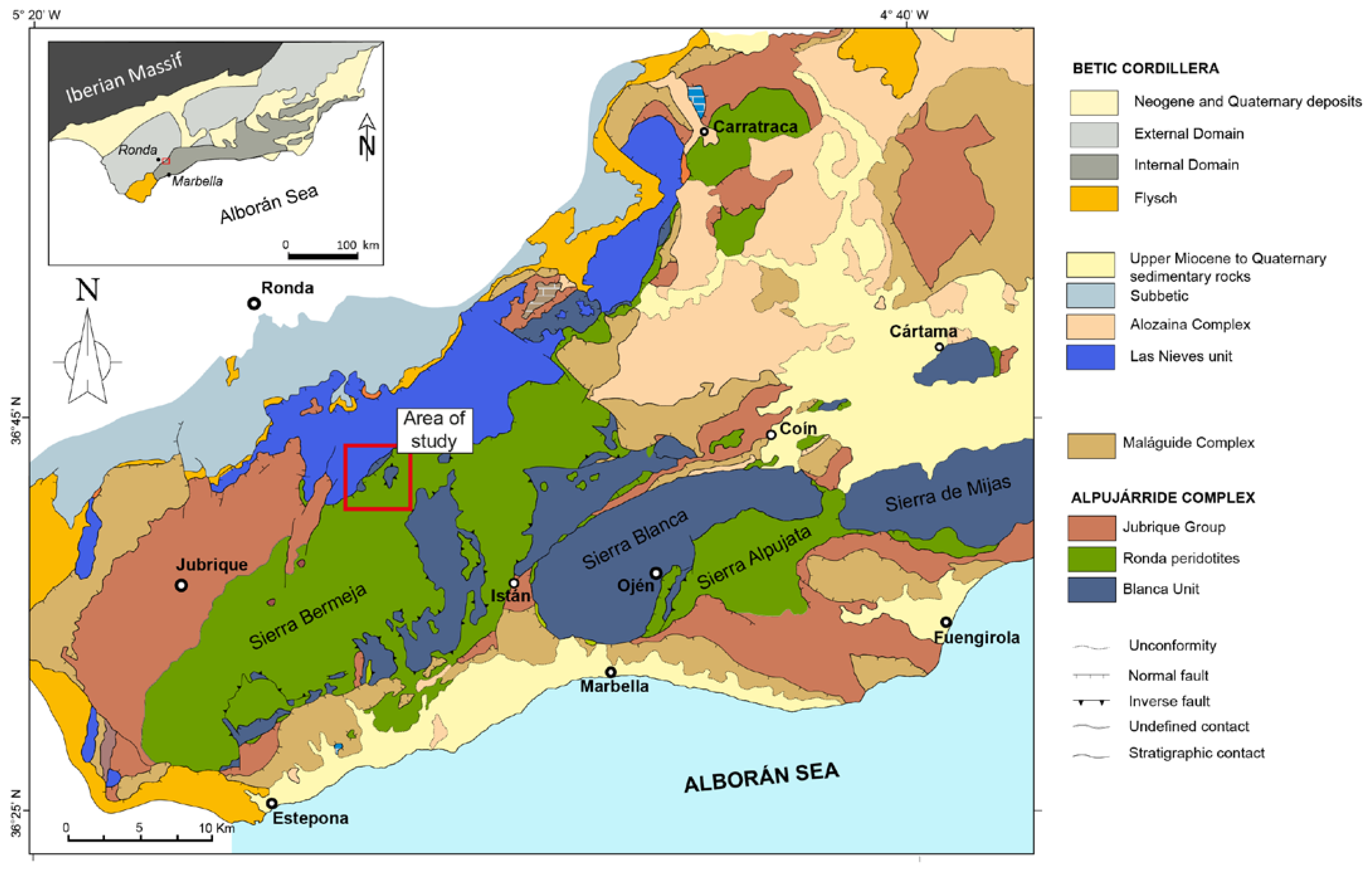

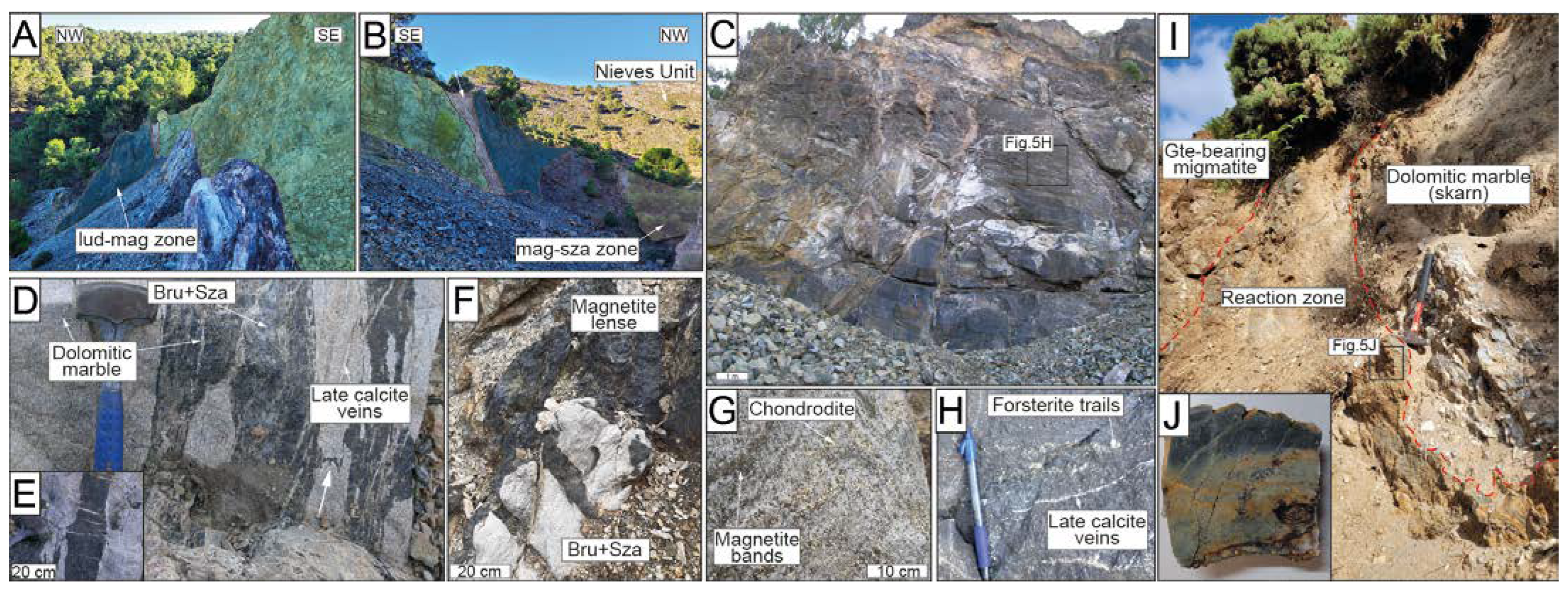
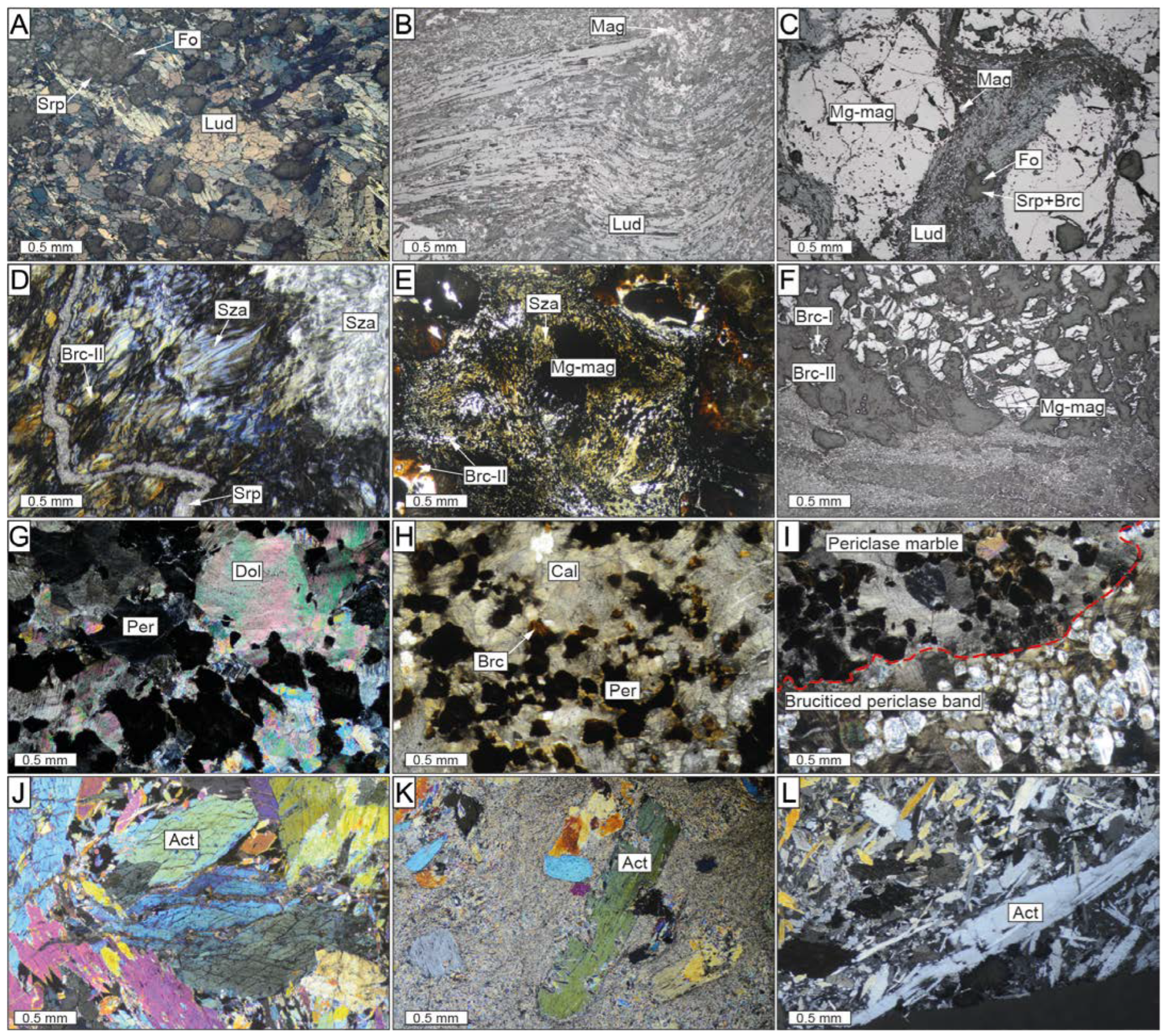
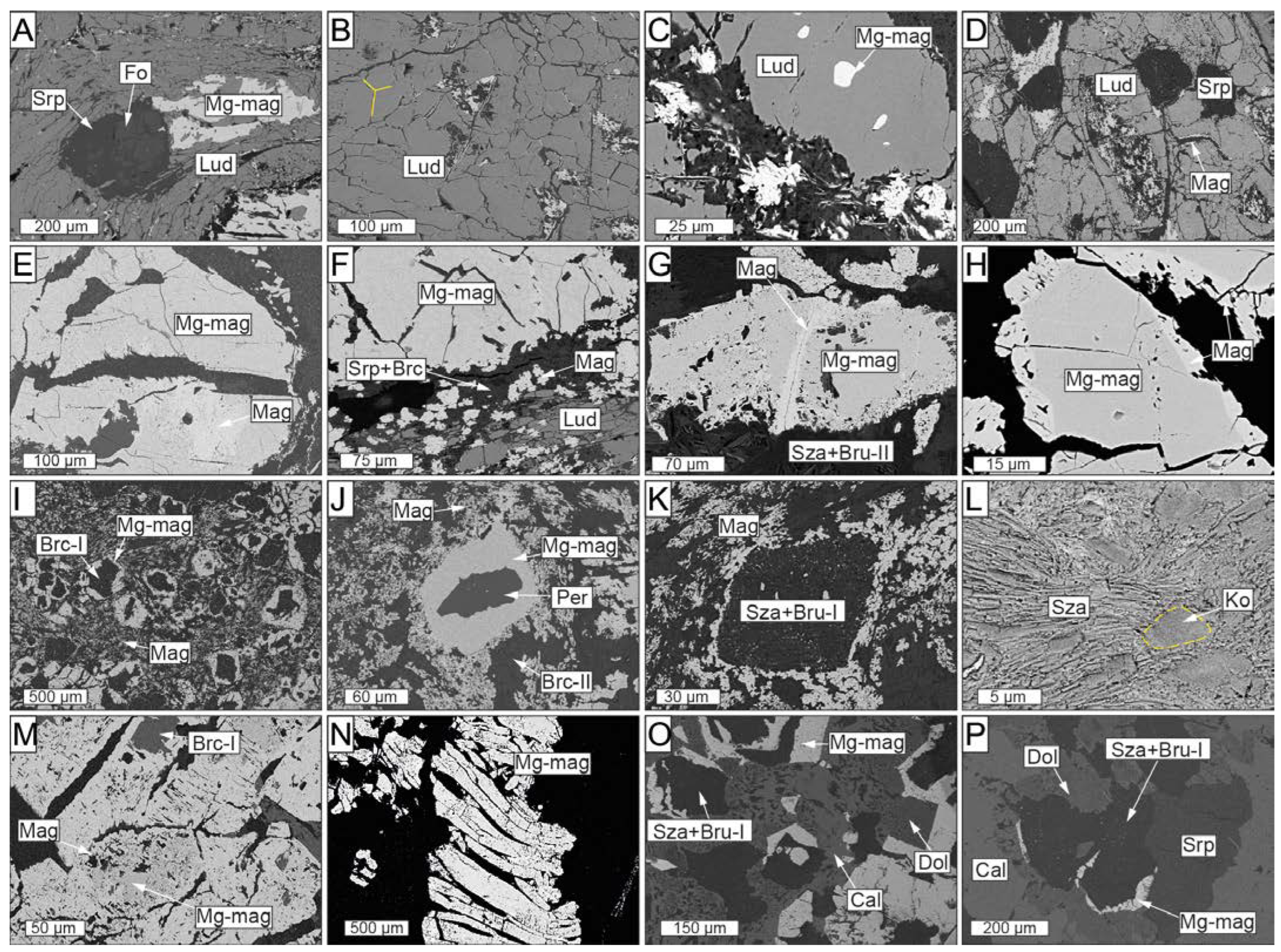

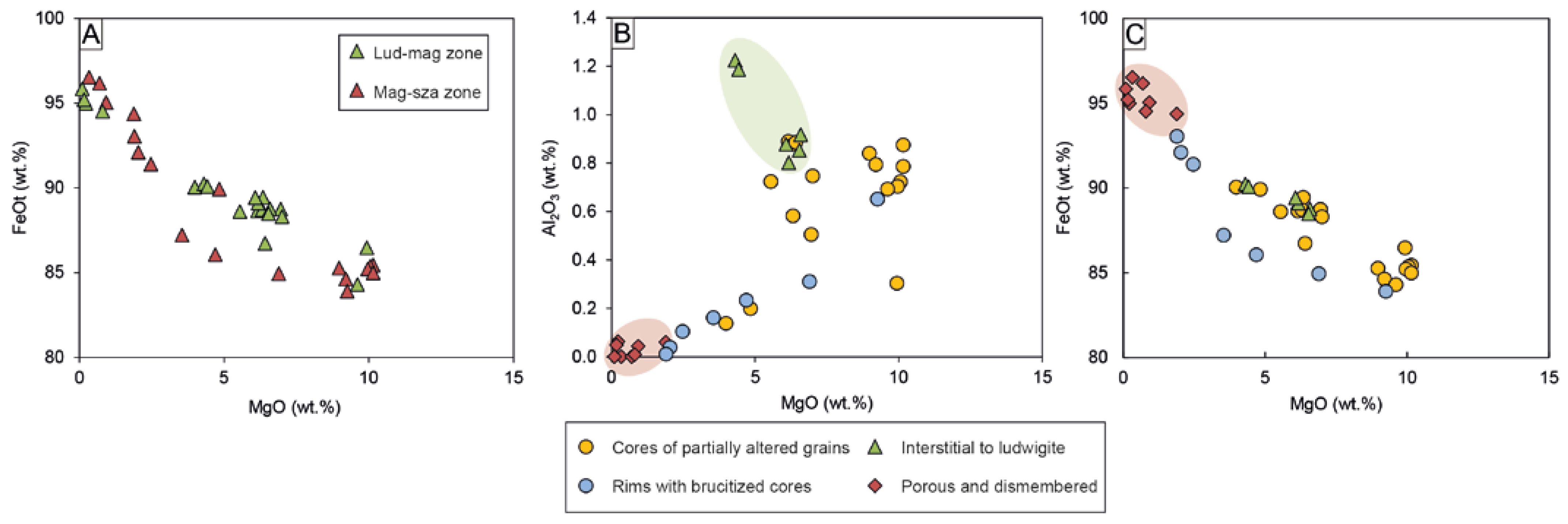
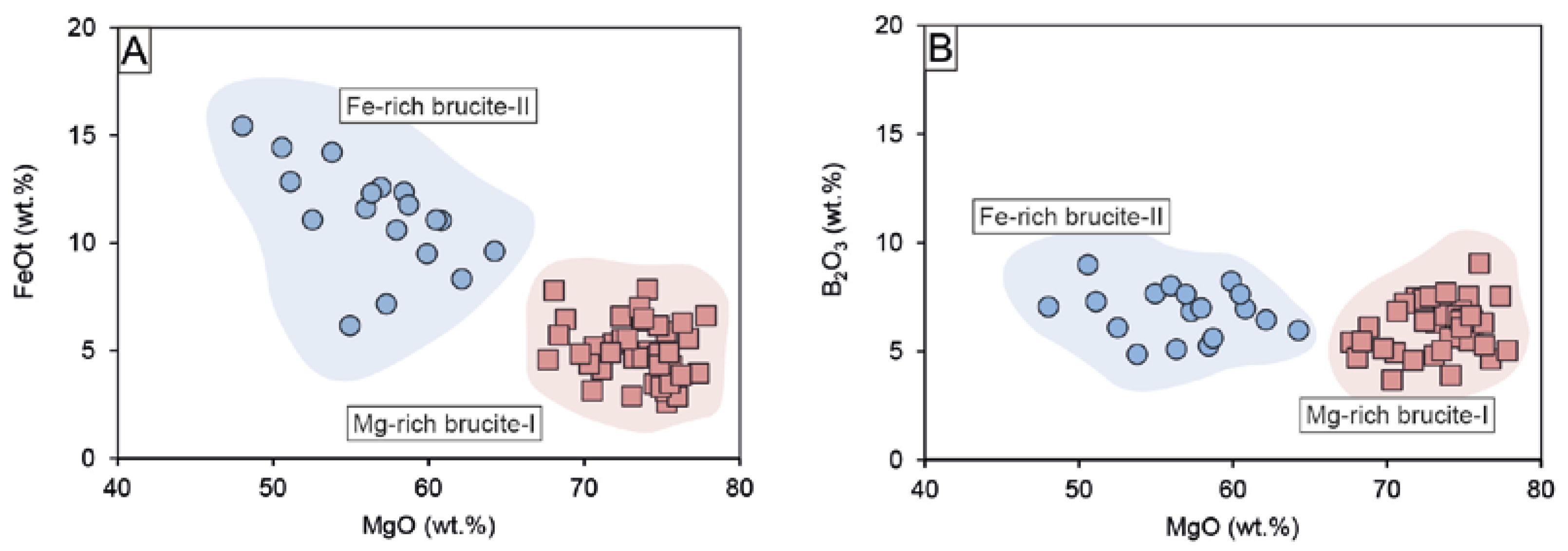
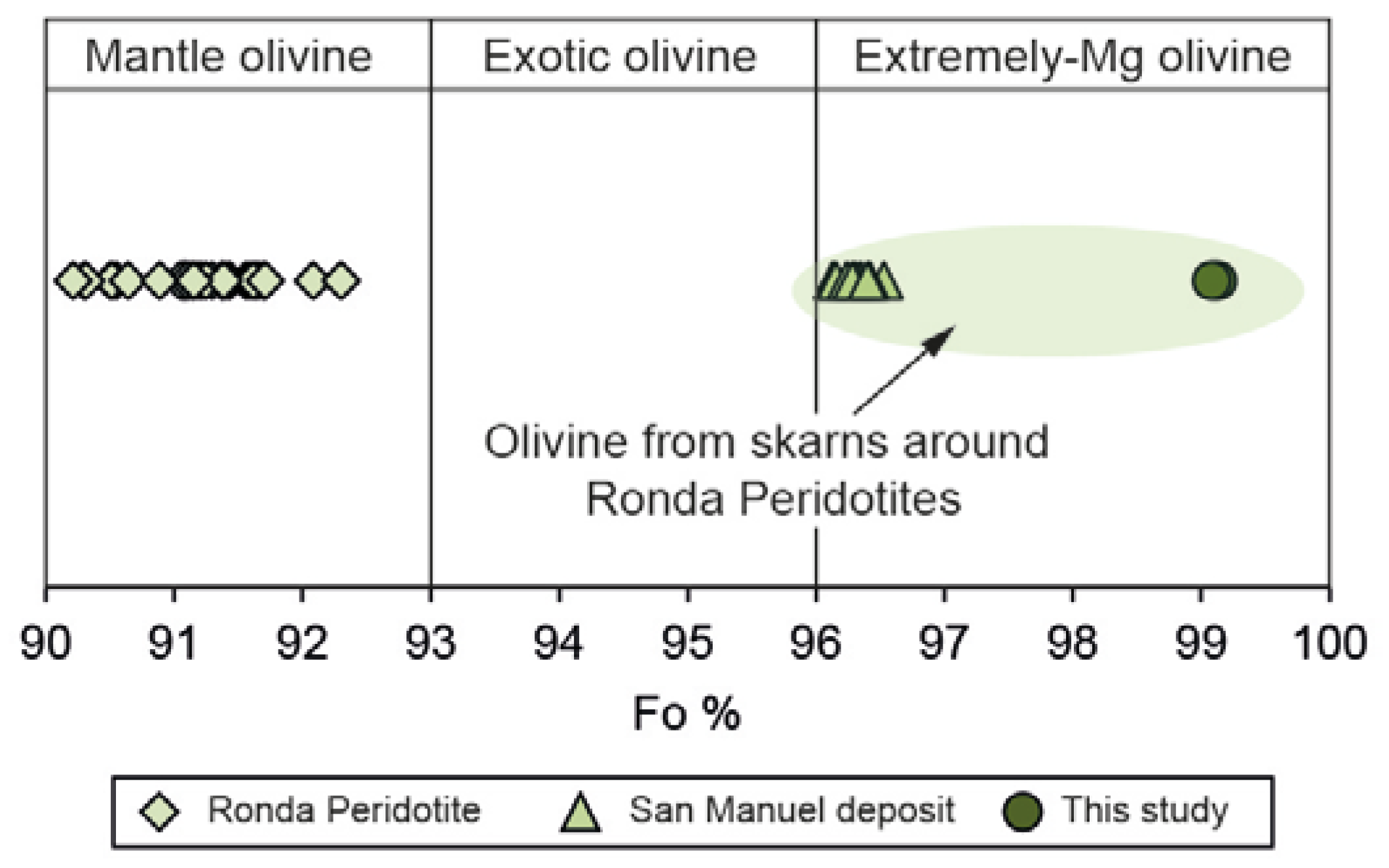


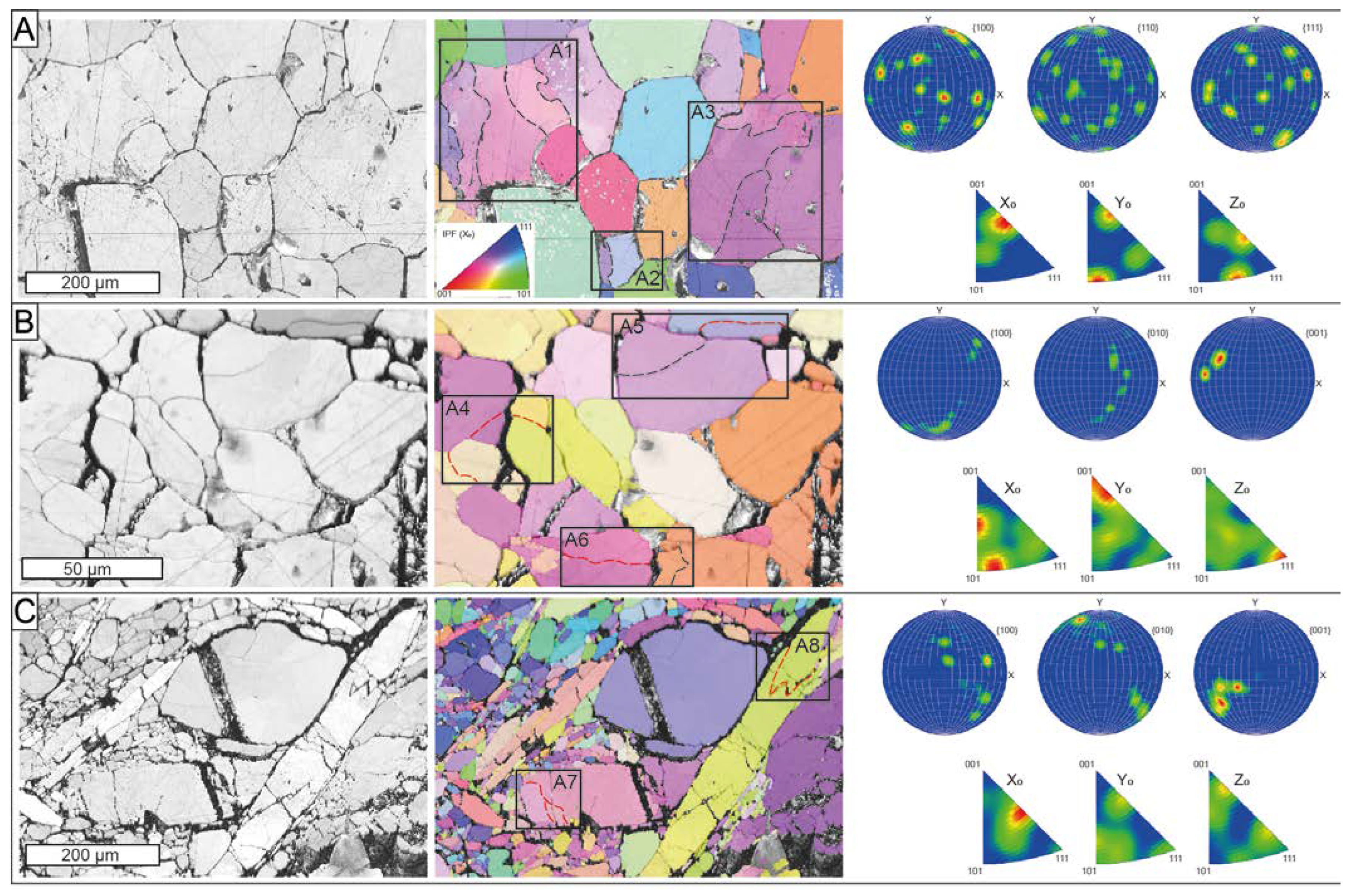
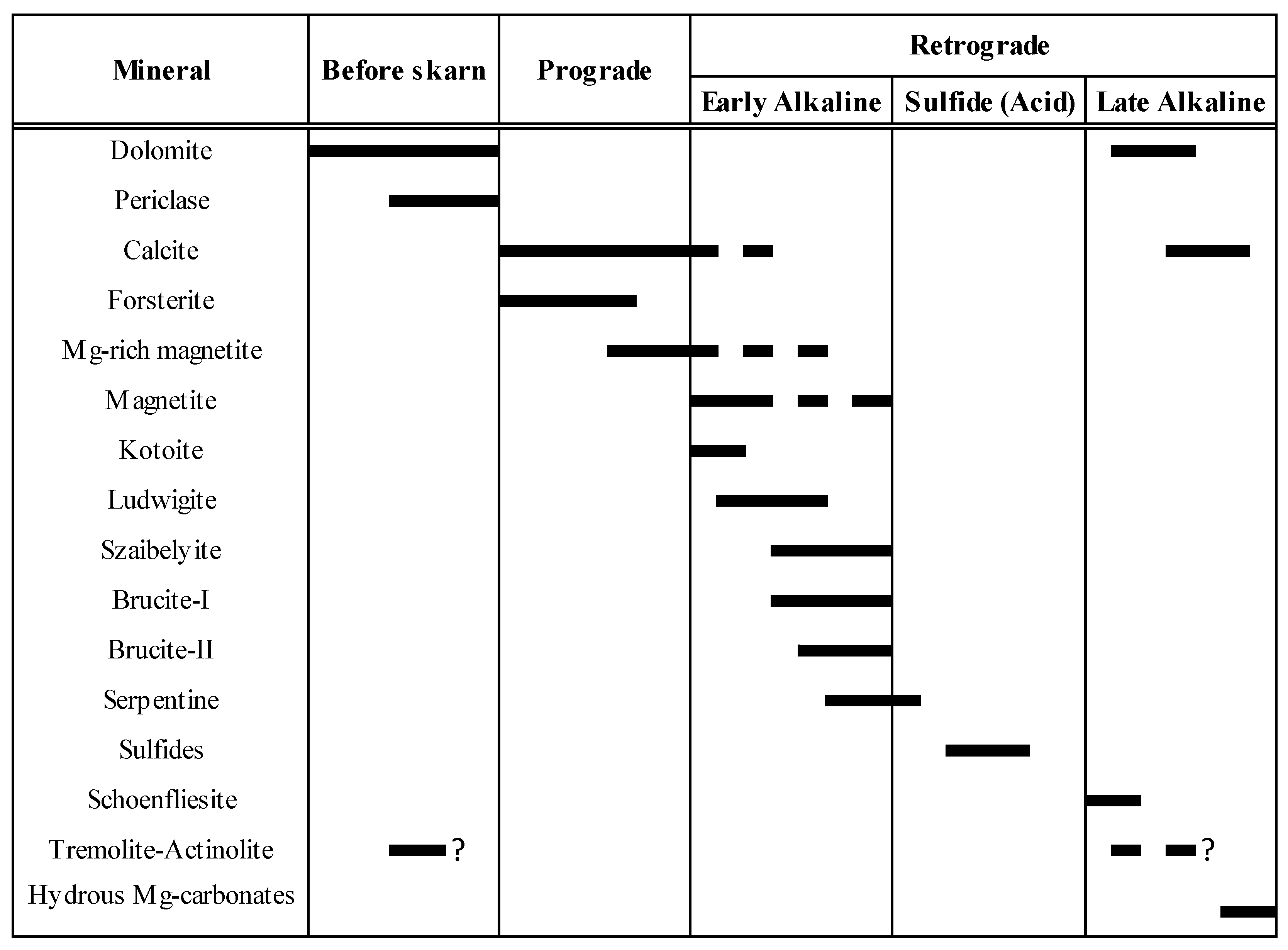

Disclaimer/Publisher’s Note: The statements, opinions and data contained in all publications are solely those of the individual author(s) and contributor(s) and not of MDPI and/or the editor(s). MDPI and/or the editor(s) disclaim responsibility for any injury to people or property resulting from any ideas, methods, instructions or products referred to in the content. |
© 2023 by the authors. Licensee MDPI, Basel, Switzerland. This article is an open access article distributed under the terms and conditions of the Creative Commons Attribution (CC BY) license (https://creativecommons.org/licenses/by/4.0/).
Share and Cite
González-Pérez, I.; Fanlo, I.; Ares, G.; Gervilla, F.; González-Jiménez, J.M.; Acosta-Vigil, A.; Arranz, E. The Unconventional Peridotite-Related Mg-Fe-B Skarn of the El Robledal, SE Spain. Minerals 2023, 13, 300. https://doi.org/10.3390/min13030300
González-Pérez I, Fanlo I, Ares G, Gervilla F, González-Jiménez JM, Acosta-Vigil A, Arranz E. The Unconventional Peridotite-Related Mg-Fe-B Skarn of the El Robledal, SE Spain. Minerals. 2023; 13(3):300. https://doi.org/10.3390/min13030300
Chicago/Turabian StyleGonzález-Pérez, Igor, Isabel Fanlo, Gonzalo Ares, Fernando Gervilla, José María González-Jiménez, Antonio Acosta-Vigil, and Enrique Arranz. 2023. "The Unconventional Peridotite-Related Mg-Fe-B Skarn of the El Robledal, SE Spain" Minerals 13, no. 3: 300. https://doi.org/10.3390/min13030300
APA StyleGonzález-Pérez, I., Fanlo, I., Ares, G., Gervilla, F., González-Jiménez, J. M., Acosta-Vigil, A., & Arranz, E. (2023). The Unconventional Peridotite-Related Mg-Fe-B Skarn of the El Robledal, SE Spain. Minerals, 13(3), 300. https://doi.org/10.3390/min13030300





